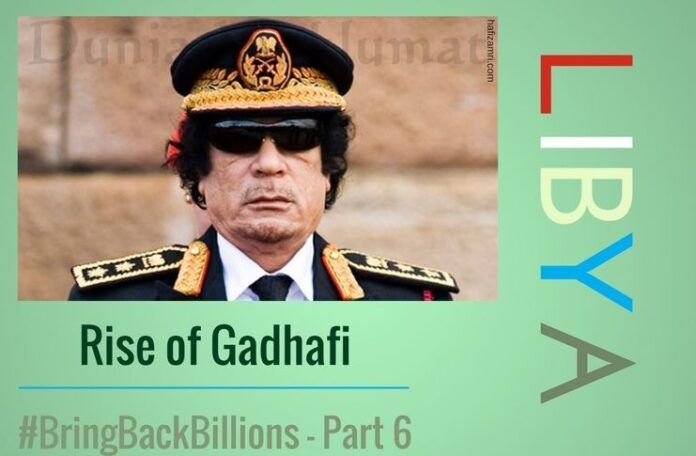
In Part 1, we described the approaches that can be used to bring back Black Money. Part 2 described how Marcos looted Philippines. In Part 3, we discussed the efforts of the Philippines Government in bringing back the money of Marcos. The next two segments, Part 4 and Part 5 detail how Mubarak amassed his fortunes and the efforts of the Illicit Gains Authority (IGA) of Egypt in recovering back the ill-gotten gains.
Libya was a monarchy, ruled by King Idris, the first and only ruler of Libya from 1951 to 1969. He was recognized as Emir of Cyrenaica by the British in 1916 but the ruling Italians were not agreeable and he went into exile in Egypt fighting against Italy’s occupation of Libya. During World War II, he fought alongside the British troops, helping them with valuable intelligence information that enabled the British to defeat Germany and Italy in Libya.
In 1949, with the help of the British, Idris proclaimed an independent Emirate of Cyrenaica. He then set about uniting the three regions of North West Africa, Cyrenaica, Tripolitania, and Fezzan to create a United Kingdom of Libya on December 24, 1951. He ruled till 1969 and in absence of a male heir, nominated his brother’s son Prince Hasan as-Senussi, as his heir and was to abdicate the throne on September 2, 1969, so Prince Hasan could ascend the throne.
On 1 September 1969, while Idris was in Greece for medical treatment, he was deposed in a coup d’état by a group of Libyan Army officers under the leadership of Muammar Gaddafi. The monarchy was abolished and a republic proclaimed. Gadhafi then proceeded to nationalize the oil industry of Libya and was among the first ones to control the price of crude by controlling production. By 1973, all the oil companies in Libya were nationalized and thanks to the formation of OPEC (Organization of the Petroleum Exporting Countries) the standard of living of Libya improved. By 1979, the average per-capita income was $8170 and was above that of Italy and the United Kingdom.
Libya’s breakneck growth fueled by Oil revenues has also spawned into some other areas. It is rumored that Gadhafi was propping up Mugabe’s regime in Zimbabwe and that he had given money to the Zaghawan tribe in Darfur, Sudan (not verified).
Where was the money made?
“The Gaddafi family could have billions of dollars of funds hidden in secret bank accounts in Dubai, south-east Asia and the Persian Gulf, much of it likely to have come from Libya’s vast oil revenues,” according to analysis by leading Middle East experts quoted by the Guardian.
Professor Tim Niblock, a specialist in Middle Eastern politics at the University of Exeter, has identified a gap of several billion dollars a year between the amount Libya makes from its oil reserves and government spending – a shortfall he expects has contributed greatly to the wealth of Muammar Gaddafi and his nine children.
Libya has an investment organization called the LIA (Libyan Investment Authority), set up in 2006 which boasts of a $60 billion dollar budget. Some of Libya’s investments include Pearson Group, the owner of the Financial Times. Other investments in the UK include an eight-bedroom home in Hampstead, north London, with a swimming pool and suede-lined cinema room. Saif al-Islam Gaddafi, the Libyan leader’s second son, bought it in 2009 for £10m.
LIA bought 3% of Pearson last year for £224m, making it one of the group’s biggest shareholders, and had a 0.02% stake in Royal Bank of Scotland (RBS), although this was sold in 2011.
Its UK property investments include Portman House, a 146,550 sq ft retail complex in Oxford Street, London, which houses retailers such as Boots and New Look, and an office at 14 Cornhill, opposite the Bank of England in the City.
Relationships with other world leaders
Gadhafi shared a special relationship with Silvio Berlusconi, the then Premier of Italy and a businessman. Libyan investors held significant interests in several strategic Italian enterprises. They reportedly own around one percent of Italy’s biggest oil company, Eni; the LIA has an acknowledged 2% interest in the aerospace and defence group, Finmeccanica; Lafico is thought to retain more than 2% of Fiat and almost 15% of a quoted telecommunications company, Retelit.
In the next segment, we will see that Gadhafi may have had up to $200 billion dollars stashed away in various countries and the efforts taken by the successor government to bring it back.
Click here for the next part in #BringBackBillions Part 7 – Recovery process after Gaddafi
- Indian Parliament’s Special Session is convened to mark the shifting to new Parliament building - September 3, 2023
- Why did Rajat Sharma of India TV not declare that Adani owns more than 16% shares in his channel? - January 29, 2023
- Prannoy Roy to get Rs.605 crore from Adani as per Stock Exchange filing. Why is Income Tax not acting on Roys’ dues of over Rs.800 crore? - January 4, 2023










